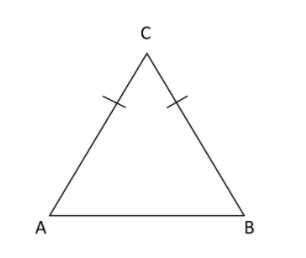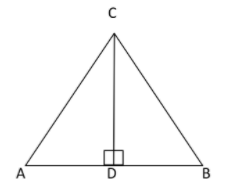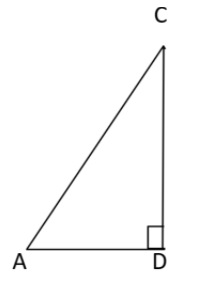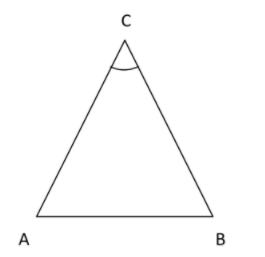Answer
397.5k+ views
Hint: Check the nature of triangle and you are given $AC = BC$ and $A{B^2} = 2A{C^2}$, then you can check whether the triangle is right angled triangle by checking Pythagoras theorem. You can apply this theorem and get your answer.
Complete step-by-step answer:
First of all, draw the sketch of $\vartriangle ABC$ and note down the condition given in the question.

According to question, it is saying that sides $AC = BC$ (1)
And $A{B^2} = 2A{C^2}$ (2)
Now drop a perpendicular from C to AB that meets AB at D.

Hence, we draw perpendicular from C to AB and hence,
$\angle CDA = \angle CDB = {90^ \circ }$
Now you can check and compare the two triangles ,i.e., $\vartriangle ADC$ and $\vartriangle BDC$
We can check the congruence of both the triangles. So,
In $\vartriangle ADC$ and $\vartriangle BDC$
$AC = BC$ (As it is given in the question)
$\angle ADC = \angle BDC$ (Both are equal to ${90^ \circ }$as we drop the perpendicular from C to AB)
$CD = CD$ (Both are common for both the triangle)
Hence, both triangles are congruent by RHS congruence property.
$\vartriangle ADC \cong \vartriangle BDC$ (By RHS property)
Now from CPCT, (corresponding part of congruent triangle)
$AD = BD$ (3)
$\angle ACD = \angle BCD$ (4)
And $\angle CAD = \angle CBD$
(As we know, corresponding parts are equal for congruent triangle.)
Hence, we got $AD = BD$.
Hence, D is the mid point of AB.
So, we can write $AD = \dfrac{{AB}}{2}$ (5)
(As D bisects AB , so it is half of AB.)
Now lets see the $\vartriangle ADC$

As we know, $\angle D = {90^ \circ }$hence it is right angled triangle , hence can use trigonometric properties, i.e., $\sin \theta = \dfrac{{Perpendicular}}{{{\text{Hypotenuse}}}}$
$\sin \angle ACD = \dfrac{{AD}}{{AC}}$
But we already proved that $AD = \dfrac{{AB}}{2}$
So,
$\sin \angle ACD = \dfrac{{AB}}{{2AC}}$ (6)
Now, in question, you are given condition
$A{B^2} = 2A{C^2}$
Taking square root on both side,
$AB = \sqrt 2 AC$
Now putting $AB = \sqrt 2 AC$ in equation (6)
$
\sin \angle ACD = \dfrac{{\sqrt 2 AC}}{{2AC}} \\
= \dfrac{{\sqrt 2 }}{2} = \dfrac{1}{{\sqrt 2 }} \\
$
And this is known that $\sin {45^ \circ } = \dfrac{1}{{\sqrt 2 }}$
Hence, you will get $\angle ACD = {45^ \circ }$
Now we have proved in equation (4)
$\angle ACD = \angle BCD = {45^ \circ }$
So,
$
\angle C = \angle ACD + \angle BCD \\
= {45^ \circ } + {45^ \circ } \\
= {90^ \circ } \\
$
So, the correct answer is “Option D”.
Note: You may use an alternative method to find angle to save your time. You know $AC = BC$ and $A{B^2} = 2A{C^2}$, we know the formula
$\cos C = \dfrac{{A{C^2} + B{C^2} - A{B^2}}}{{2\left( {AC} \right)\left( {BC} \right)}}$

Now take
$
AC = BC = a \\
A{B^2} = 2{\left( {AC} \right)^2} = 2{a^2} \\
AB = \sqrt 2 a \\
\\
$
$
\cos C = \dfrac{{{a^2} + {a^2} - 2{a^2}}}{{2a \times a}} \\
\cos C = \dfrac{{2{a^2} - 2{a^2}}}{{2{a^2}}} \\
\cos C = 0 \\
C = {90^ \circ } \\
$
Complete step-by-step answer:
First of all, draw the sketch of $\vartriangle ABC$ and note down the condition given in the question.

According to question, it is saying that sides $AC = BC$ (1)
And $A{B^2} = 2A{C^2}$ (2)
Now drop a perpendicular from C to AB that meets AB at D.

Hence, we draw perpendicular from C to AB and hence,
$\angle CDA = \angle CDB = {90^ \circ }$
Now you can check and compare the two triangles ,i.e., $\vartriangle ADC$ and $\vartriangle BDC$
We can check the congruence of both the triangles. So,
In $\vartriangle ADC$ and $\vartriangle BDC$
$AC = BC$ (As it is given in the question)
$\angle ADC = \angle BDC$ (Both are equal to ${90^ \circ }$as we drop the perpendicular from C to AB)
$CD = CD$ (Both are common for both the triangle)
Hence, both triangles are congruent by RHS congruence property.
$\vartriangle ADC \cong \vartriangle BDC$ (By RHS property)
Now from CPCT, (corresponding part of congruent triangle)
$AD = BD$ (3)
$\angle ACD = \angle BCD$ (4)
And $\angle CAD = \angle CBD$
(As we know, corresponding parts are equal for congruent triangle.)
Hence, we got $AD = BD$.
Hence, D is the mid point of AB.
So, we can write $AD = \dfrac{{AB}}{2}$ (5)
(As D bisects AB , so it is half of AB.)
Now lets see the $\vartriangle ADC$

As we know, $\angle D = {90^ \circ }$hence it is right angled triangle , hence can use trigonometric properties, i.e., $\sin \theta = \dfrac{{Perpendicular}}{{{\text{Hypotenuse}}}}$
$\sin \angle ACD = \dfrac{{AD}}{{AC}}$
But we already proved that $AD = \dfrac{{AB}}{2}$
So,
$\sin \angle ACD = \dfrac{{AB}}{{2AC}}$ (6)
Now, in question, you are given condition
$A{B^2} = 2A{C^2}$
Taking square root on both side,
$AB = \sqrt 2 AC$
Now putting $AB = \sqrt 2 AC$ in equation (6)
$
\sin \angle ACD = \dfrac{{\sqrt 2 AC}}{{2AC}} \\
= \dfrac{{\sqrt 2 }}{2} = \dfrac{1}{{\sqrt 2 }} \\
$
And this is known that $\sin {45^ \circ } = \dfrac{1}{{\sqrt 2 }}$
Hence, you will get $\angle ACD = {45^ \circ }$
Now we have proved in equation (4)
$\angle ACD = \angle BCD = {45^ \circ }$
So,
$
\angle C = \angle ACD + \angle BCD \\
= {45^ \circ } + {45^ \circ } \\
= {90^ \circ } \\
$
So, the correct answer is “Option D”.
Note: You may use an alternative method to find angle to save your time. You know $AC = BC$ and $A{B^2} = 2A{C^2}$, we know the formula
$\cos C = \dfrac{{A{C^2} + B{C^2} - A{B^2}}}{{2\left( {AC} \right)\left( {BC} \right)}}$

Now take
$
AC = BC = a \\
A{B^2} = 2{\left( {AC} \right)^2} = 2{a^2} \\
AB = \sqrt 2 a \\
\\
$
$
\cos C = \dfrac{{{a^2} + {a^2} - 2{a^2}}}{{2a \times a}} \\
\cos C = \dfrac{{2{a^2} - 2{a^2}}}{{2{a^2}}} \\
\cos C = 0 \\
C = {90^ \circ } \\
$
Recently Updated Pages
The branch of science which deals with nature and natural class 10 physics CBSE

The Equation xxx + 2 is Satisfied when x is Equal to Class 10 Maths

Define absolute refractive index of a medium

Find out what do the algal bloom and redtides sign class 10 biology CBSE

Prove that the function fleft x right xn is continuous class 12 maths CBSE

Find the values of other five trigonometric functions class 10 maths CBSE

Trending doubts
State the differences between manure and fertilize class 8 biology CBSE

Why are xylem and phloem called complex tissues aBoth class 11 biology CBSE

Difference between Prokaryotic cell and Eukaryotic class 11 biology CBSE

Difference Between Plant Cell and Animal Cell

What would happen if plasma membrane ruptures or breaks class 11 biology CBSE

Give 10 examples for herbs , shrubs , climbers , creepers

What precautions do you take while observing the nucleus class 11 biology CBSE

What would happen to the life of a cell if there was class 11 biology CBSE

Change the following sentences into negative and interrogative class 10 english CBSE



